A Study of New Ways of Perceiving History and Historiography
VerifiedAdded on 2023/01/19
|8
|3008
|47
Essay
AI Summary
This essay delves into the evolving landscape of historical study, examining how new perspectives have reshaped our understanding of the past. It explores various approaches such as social history, which emphasizes the experiences of ordinary people, and history from below, which gives voice to marginalized communities. The essay also covers feminist history, microhistory, and the Annales school, highlighting how these perspectives challenge traditional narratives and offer fresh insights into historical events. Key themes include industrialization, democratization, and the concept of historical agency, demonstrating how these factors have influenced historical writing. The essay also analyzes the methodologies employed by these new schools of thought, including quantitative methods and the use of interdisciplinary approaches. Overall, the essay provides a comprehensive overview of the shifts in historiography and their impact on how we interpret the past, emphasizing the importance of diverse perspectives in historical analysis. The essay concludes with a discussion on the role of women in history and how feminist history seeks to address the neglect of their contributions.
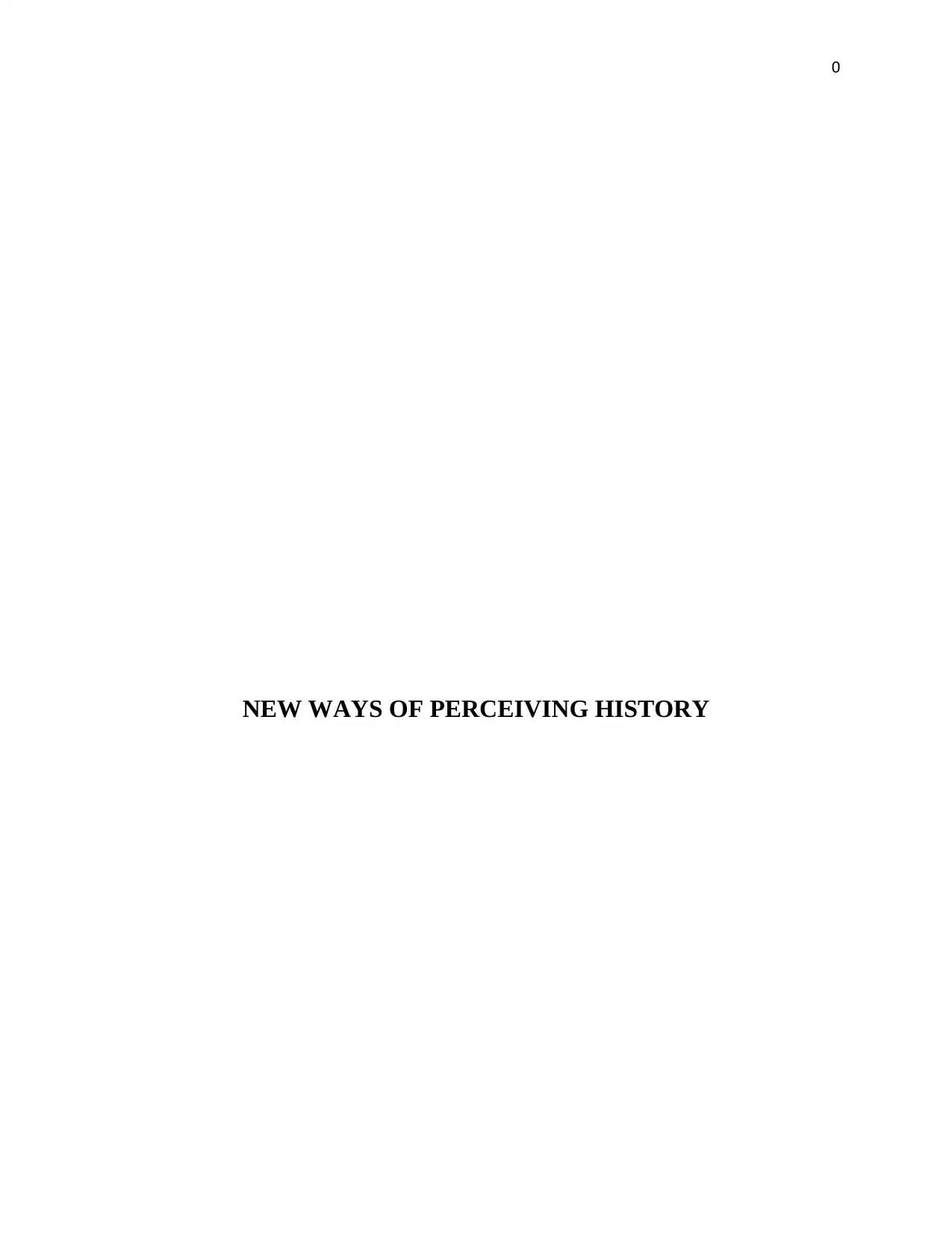
0
NEW WAYS OF PERCEIVING HISTORY
NEW WAYS OF PERCEIVING HISTORY
Paraphrase This Document
Need a fresh take? Get an instant paraphrase of this document with our AI Paraphraser
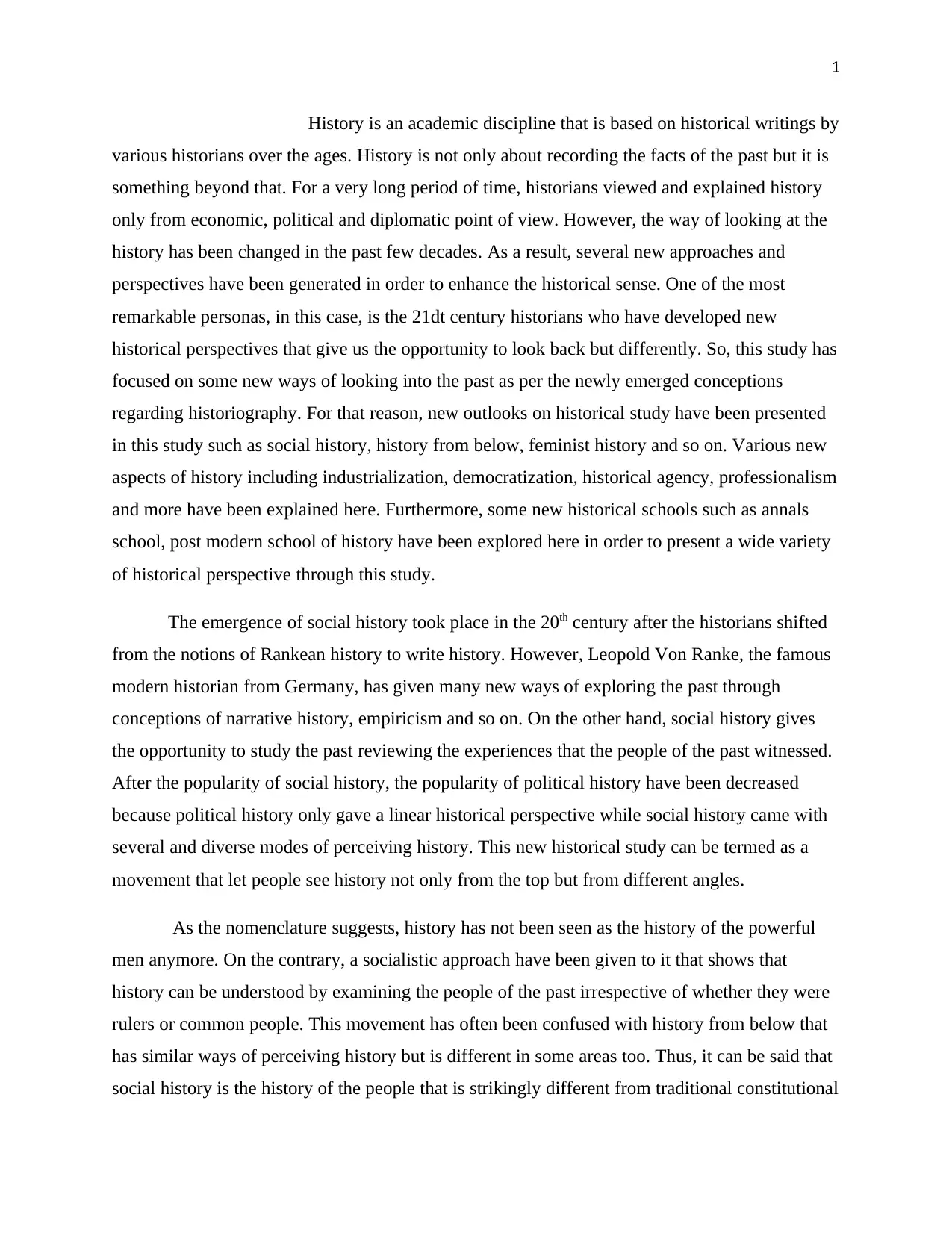
1
History is an academic discipline that is based on historical writings by
various historians over the ages. History is not only about recording the facts of the past but it is
something beyond that. For a very long period of time, historians viewed and explained history
only from economic, political and diplomatic point of view. However, the way of looking at the
history has been changed in the past few decades. As a result, several new approaches and
perspectives have been generated in order to enhance the historical sense. One of the most
remarkable personas, in this case, is the 21dt century historians who have developed new
historical perspectives that give us the opportunity to look back but differently. So, this study has
focused on some new ways of looking into the past as per the newly emerged conceptions
regarding historiography. For that reason, new outlooks on historical study have been presented
in this study such as social history, history from below, feminist history and so on. Various new
aspects of history including industrialization, democratization, historical agency, professionalism
and more have been explained here. Furthermore, some new historical schools such as annals
school, post modern school of history have been explored here in order to present a wide variety
of historical perspective through this study.
The emergence of social history took place in the 20th century after the historians shifted
from the notions of Rankean history to write history. However, Leopold Von Ranke, the famous
modern historian from Germany, has given many new ways of exploring the past through
conceptions of narrative history, empiricism and so on. On the other hand, social history gives
the opportunity to study the past reviewing the experiences that the people of the past witnessed.
After the popularity of social history, the popularity of political history have been decreased
because political history only gave a linear historical perspective while social history came with
several and diverse modes of perceiving history. This new historical study can be termed as a
movement that let people see history not only from the top but from different angles.
As the nomenclature suggests, history has not been seen as the history of the powerful
men anymore. On the contrary, a socialistic approach have been given to it that shows that
history can be understood by examining the people of the past irrespective of whether they were
rulers or common people. This movement has often been confused with history from below that
has similar ways of perceiving history but is different in some areas too. Thus, it can be said that
social history is the history of the people that is strikingly different from traditional constitutional
History is an academic discipline that is based on historical writings by
various historians over the ages. History is not only about recording the facts of the past but it is
something beyond that. For a very long period of time, historians viewed and explained history
only from economic, political and diplomatic point of view. However, the way of looking at the
history has been changed in the past few decades. As a result, several new approaches and
perspectives have been generated in order to enhance the historical sense. One of the most
remarkable personas, in this case, is the 21dt century historians who have developed new
historical perspectives that give us the opportunity to look back but differently. So, this study has
focused on some new ways of looking into the past as per the newly emerged conceptions
regarding historiography. For that reason, new outlooks on historical study have been presented
in this study such as social history, history from below, feminist history and so on. Various new
aspects of history including industrialization, democratization, historical agency, professionalism
and more have been explained here. Furthermore, some new historical schools such as annals
school, post modern school of history have been explored here in order to present a wide variety
of historical perspective through this study.
The emergence of social history took place in the 20th century after the historians shifted
from the notions of Rankean history to write history. However, Leopold Von Ranke, the famous
modern historian from Germany, has given many new ways of exploring the past through
conceptions of narrative history, empiricism and so on. On the other hand, social history gives
the opportunity to study the past reviewing the experiences that the people of the past witnessed.
After the popularity of social history, the popularity of political history have been decreased
because political history only gave a linear historical perspective while social history came with
several and diverse modes of perceiving history. This new historical study can be termed as a
movement that let people see history not only from the top but from different angles.
As the nomenclature suggests, history has not been seen as the history of the powerful
men anymore. On the contrary, a socialistic approach have been given to it that shows that
history can be understood by examining the people of the past irrespective of whether they were
rulers or common people. This movement has often been confused with history from below that
has similar ways of perceiving history but is different in some areas too. Thus, it can be said that
social history is the history of the people that is strikingly different from traditional constitutional
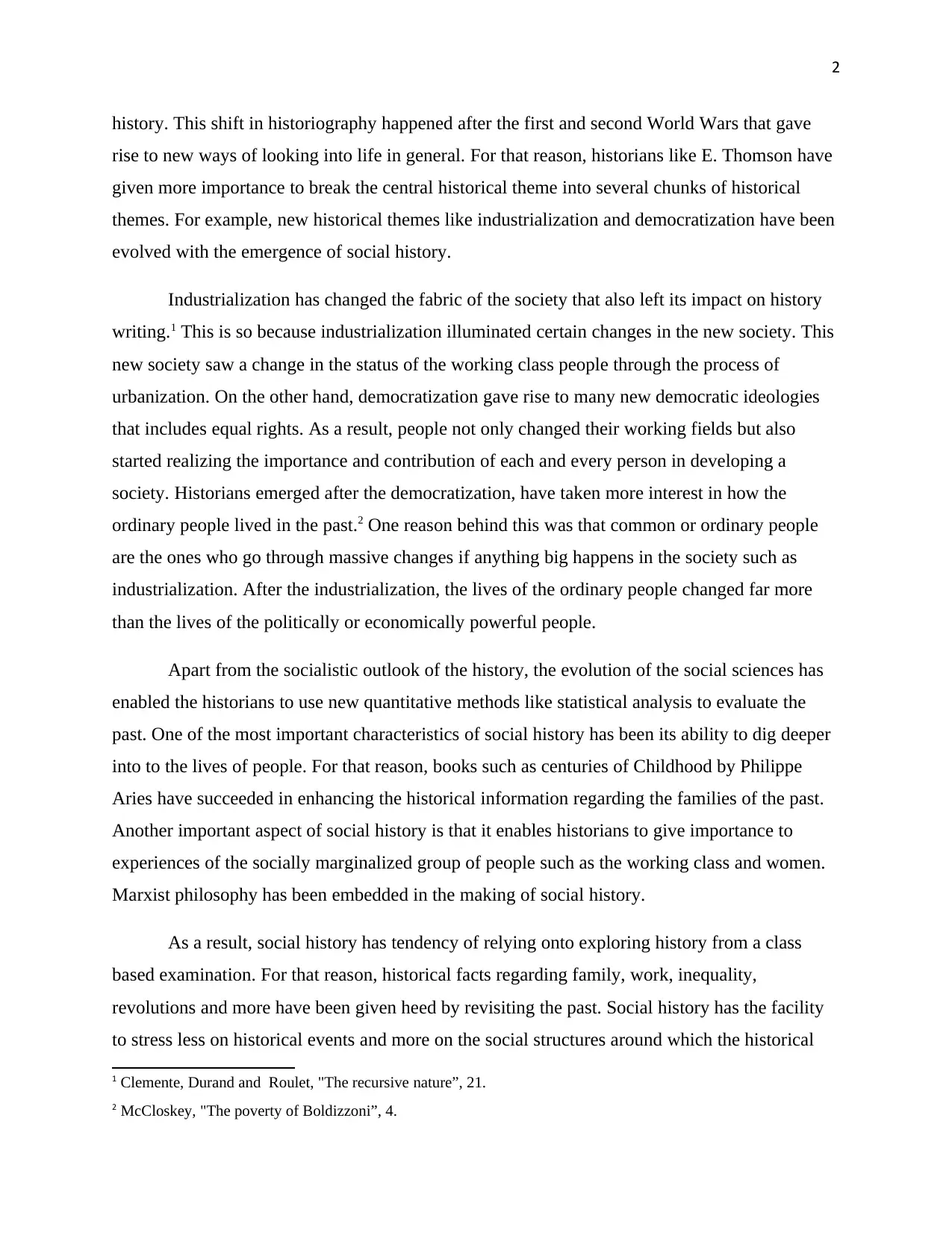
2
history. This shift in historiography happened after the first and second World Wars that gave
rise to new ways of looking into life in general. For that reason, historians like E. Thomson have
given more importance to break the central historical theme into several chunks of historical
themes. For example, new historical themes like industrialization and democratization have been
evolved with the emergence of social history.
Industrialization has changed the fabric of the society that also left its impact on history
writing.1 This is so because industrialization illuminated certain changes in the new society. This
new society saw a change in the status of the working class people through the process of
urbanization. On the other hand, democratization gave rise to many new democratic ideologies
that includes equal rights. As a result, people not only changed their working fields but also
started realizing the importance and contribution of each and every person in developing a
society. Historians emerged after the democratization, have taken more interest in how the
ordinary people lived in the past.2 One reason behind this was that common or ordinary people
are the ones who go through massive changes if anything big happens in the society such as
industrialization. After the industrialization, the lives of the ordinary people changed far more
than the lives of the politically or economically powerful people.
Apart from the socialistic outlook of the history, the evolution of the social sciences has
enabled the historians to use new quantitative methods like statistical analysis to evaluate the
past. One of the most important characteristics of social history has been its ability to dig deeper
into to the lives of people. For that reason, books such as centuries of Childhood by Philippe
Aries have succeeded in enhancing the historical information regarding the families of the past.
Another important aspect of social history is that it enables historians to give importance to
experiences of the socially marginalized group of people such as the working class and women.
Marxist philosophy has been embedded in the making of social history.
As a result, social history has tendency of relying onto exploring history from a class
based examination. For that reason, historical facts regarding family, work, inequality,
revolutions and more have been given heed by revisiting the past. Social history has the facility
to stress less on historical events and more on the social structures around which the historical
1 Clemente, Durand and Roulet, "The recursive nature”, 21.
2 McCloskey, "The poverty of Boldizzoni”, 4.
history. This shift in historiography happened after the first and second World Wars that gave
rise to new ways of looking into life in general. For that reason, historians like E. Thomson have
given more importance to break the central historical theme into several chunks of historical
themes. For example, new historical themes like industrialization and democratization have been
evolved with the emergence of social history.
Industrialization has changed the fabric of the society that also left its impact on history
writing.1 This is so because industrialization illuminated certain changes in the new society. This
new society saw a change in the status of the working class people through the process of
urbanization. On the other hand, democratization gave rise to many new democratic ideologies
that includes equal rights. As a result, people not only changed their working fields but also
started realizing the importance and contribution of each and every person in developing a
society. Historians emerged after the democratization, have taken more interest in how the
ordinary people lived in the past.2 One reason behind this was that common or ordinary people
are the ones who go through massive changes if anything big happens in the society such as
industrialization. After the industrialization, the lives of the ordinary people changed far more
than the lives of the politically or economically powerful people.
Apart from the socialistic outlook of the history, the evolution of the social sciences has
enabled the historians to use new quantitative methods like statistical analysis to evaluate the
past. One of the most important characteristics of social history has been its ability to dig deeper
into to the lives of people. For that reason, books such as centuries of Childhood by Philippe
Aries have succeeded in enhancing the historical information regarding the families of the past.
Another important aspect of social history is that it enables historians to give importance to
experiences of the socially marginalized group of people such as the working class and women.
Marxist philosophy has been embedded in the making of social history.
As a result, social history has tendency of relying onto exploring history from a class
based examination. For that reason, historical facts regarding family, work, inequality,
revolutions and more have been given heed by revisiting the past. Social history has the facility
to stress less on historical events and more on the social structures around which the historical
1 Clemente, Durand and Roulet, "The recursive nature”, 21.
2 McCloskey, "The poverty of Boldizzoni”, 4.
⊘ This is a preview!⊘
Do you want full access?
Subscribe today to unlock all pages.

Trusted by 1+ million students worldwide
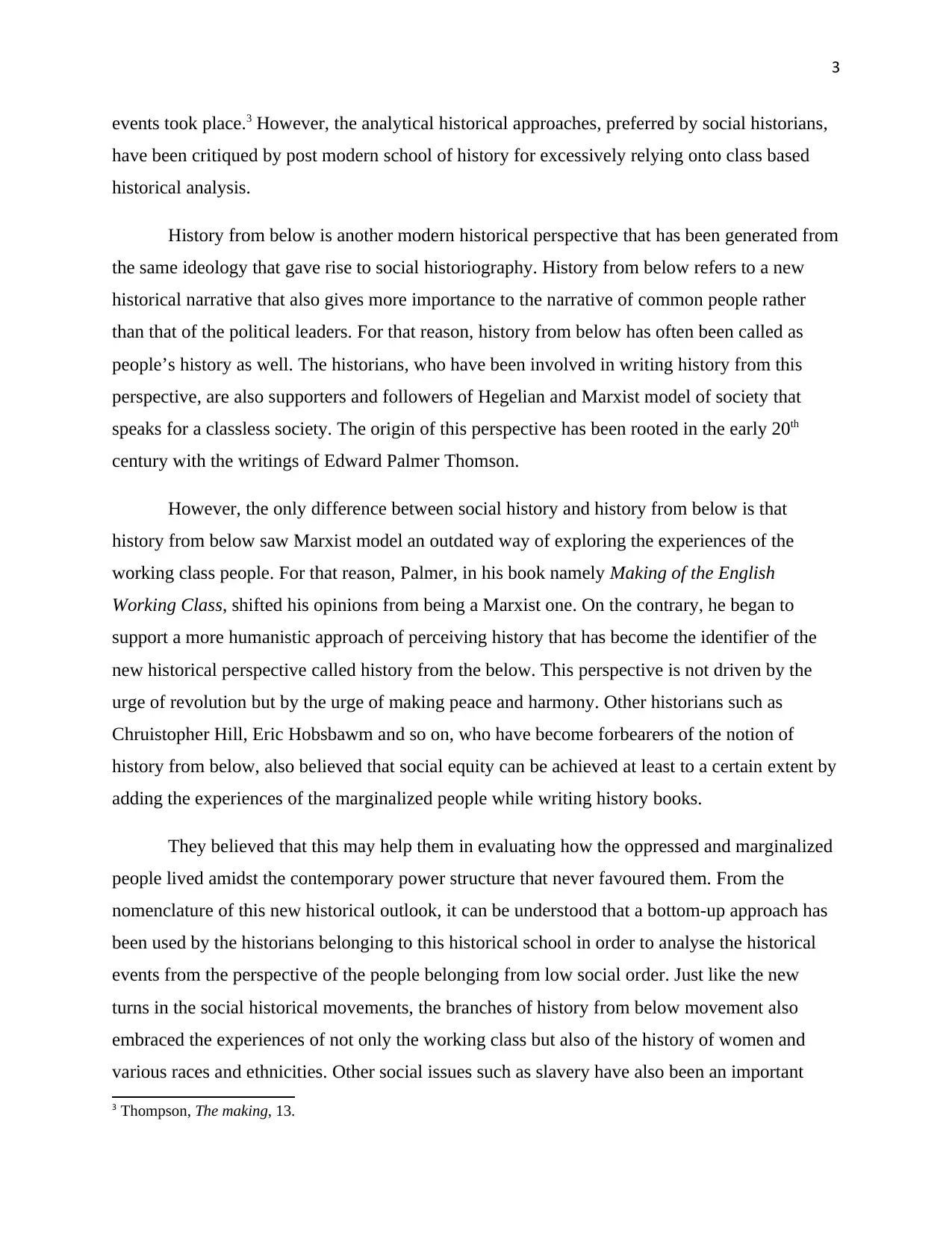
3
events took place.3 However, the analytical historical approaches, preferred by social historians,
have been critiqued by post modern school of history for excessively relying onto class based
historical analysis.
History from below is another modern historical perspective that has been generated from
the same ideology that gave rise to social historiography. History from below refers to a new
historical narrative that also gives more importance to the narrative of common people rather
than that of the political leaders. For that reason, history from below has often been called as
people’s history as well. The historians, who have been involved in writing history from this
perspective, are also supporters and followers of Hegelian and Marxist model of society that
speaks for a classless society. The origin of this perspective has been rooted in the early 20th
century with the writings of Edward Palmer Thomson.
However, the only difference between social history and history from below is that
history from below saw Marxist model an outdated way of exploring the experiences of the
working class people. For that reason, Palmer, in his book namely Making of the English
Working Class, shifted his opinions from being a Marxist one. On the contrary, he began to
support a more humanistic approach of perceiving history that has become the identifier of the
new historical perspective called history from the below. This perspective is not driven by the
urge of revolution but by the urge of making peace and harmony. Other historians such as
Chruistopher Hill, Eric Hobsbawm and so on, who have become forbearers of the notion of
history from below, also believed that social equity can be achieved at least to a certain extent by
adding the experiences of the marginalized people while writing history books.
They believed that this may help them in evaluating how the oppressed and marginalized
people lived amidst the contemporary power structure that never favoured them. From the
nomenclature of this new historical outlook, it can be understood that a bottom-up approach has
been used by the historians belonging to this historical school in order to analyse the historical
events from the perspective of the people belonging from low social order. Just like the new
turns in the social historical movements, the branches of history from below movement also
embraced the experiences of not only the working class but also of the history of women and
various races and ethnicities. Other social issues such as slavery have also been an important
3 Thompson, The making, 13.
events took place.3 However, the analytical historical approaches, preferred by social historians,
have been critiqued by post modern school of history for excessively relying onto class based
historical analysis.
History from below is another modern historical perspective that has been generated from
the same ideology that gave rise to social historiography. History from below refers to a new
historical narrative that also gives more importance to the narrative of common people rather
than that of the political leaders. For that reason, history from below has often been called as
people’s history as well. The historians, who have been involved in writing history from this
perspective, are also supporters and followers of Hegelian and Marxist model of society that
speaks for a classless society. The origin of this perspective has been rooted in the early 20th
century with the writings of Edward Palmer Thomson.
However, the only difference between social history and history from below is that
history from below saw Marxist model an outdated way of exploring the experiences of the
working class people. For that reason, Palmer, in his book namely Making of the English
Working Class, shifted his opinions from being a Marxist one. On the contrary, he began to
support a more humanistic approach of perceiving history that has become the identifier of the
new historical perspective called history from the below. This perspective is not driven by the
urge of revolution but by the urge of making peace and harmony. Other historians such as
Chruistopher Hill, Eric Hobsbawm and so on, who have become forbearers of the notion of
history from below, also believed that social equity can be achieved at least to a certain extent by
adding the experiences of the marginalized people while writing history books.
They believed that this may help them in evaluating how the oppressed and marginalized
people lived amidst the contemporary power structure that never favoured them. From the
nomenclature of this new historical outlook, it can be understood that a bottom-up approach has
been used by the historians belonging to this historical school in order to analyse the historical
events from the perspective of the people belonging from low social order. Just like the new
turns in the social historical movements, the branches of history from below movement also
embraced the experiences of not only the working class but also of the history of women and
various races and ethnicities. Other social issues such as slavery have also been an important
3 Thompson, The making, 13.
Paraphrase This Document
Need a fresh take? Get an instant paraphrase of this document with our AI Paraphraser
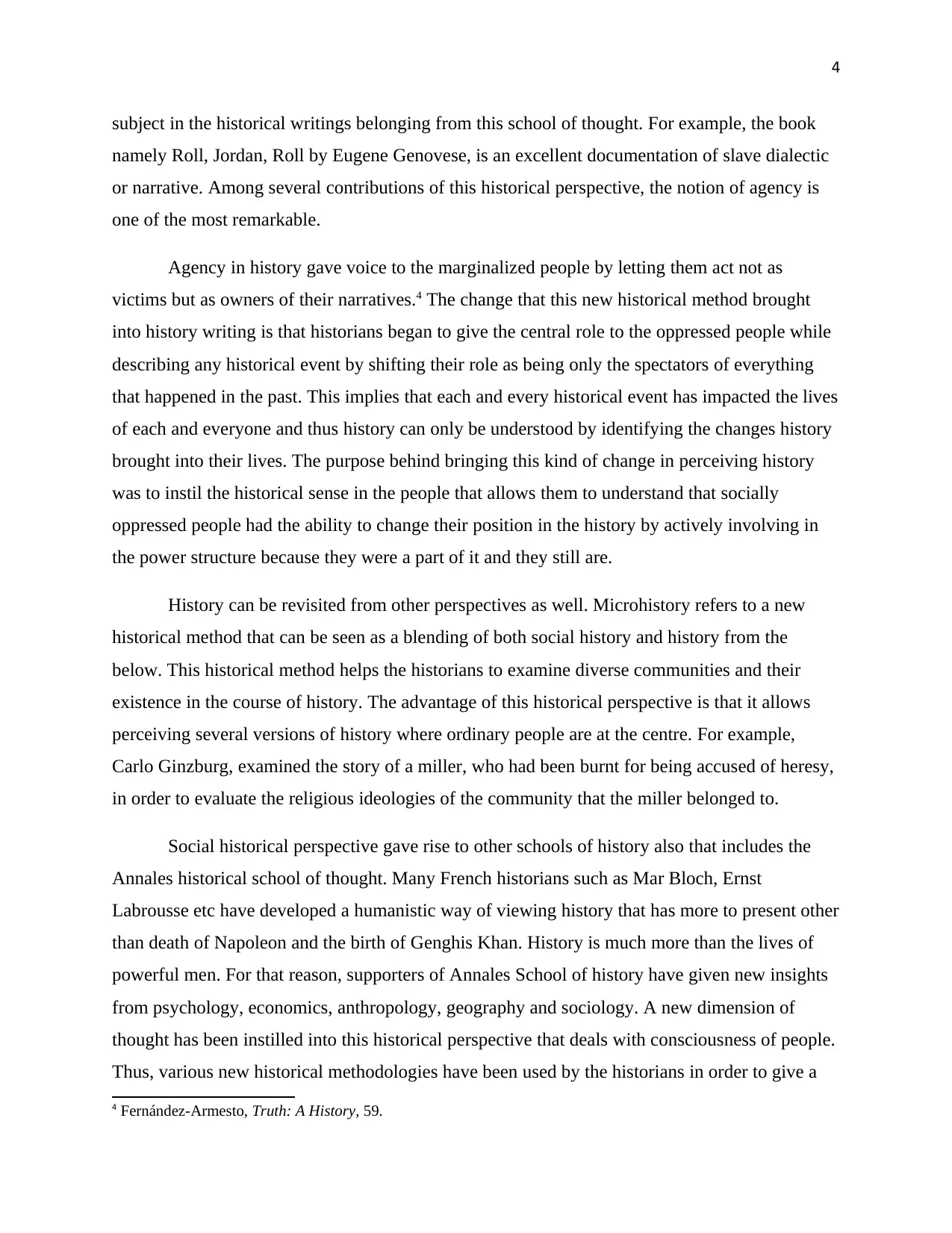
4
subject in the historical writings belonging from this school of thought. For example, the book
namely Roll, Jordan, Roll by Eugene Genovese, is an excellent documentation of slave dialectic
or narrative. Among several contributions of this historical perspective, the notion of agency is
one of the most remarkable.
Agency in history gave voice to the marginalized people by letting them act not as
victims but as owners of their narratives.4 The change that this new historical method brought
into history writing is that historians began to give the central role to the oppressed people while
describing any historical event by shifting their role as being only the spectators of everything
that happened in the past. This implies that each and every historical event has impacted the lives
of each and everyone and thus history can only be understood by identifying the changes history
brought into their lives. The purpose behind bringing this kind of change in perceiving history
was to instil the historical sense in the people that allows them to understand that socially
oppressed people had the ability to change their position in the history by actively involving in
the power structure because they were a part of it and they still are.
History can be revisited from other perspectives as well. Microhistory refers to a new
historical method that can be seen as a blending of both social history and history from the
below. This historical method helps the historians to examine diverse communities and their
existence in the course of history. The advantage of this historical perspective is that it allows
perceiving several versions of history where ordinary people are at the centre. For example,
Carlo Ginzburg, examined the story of a miller, who had been burnt for being accused of heresy,
in order to evaluate the religious ideologies of the community that the miller belonged to.
Social historical perspective gave rise to other schools of history also that includes the
Annales historical school of thought. Many French historians such as Mar Bloch, Ernst
Labrousse etc have developed a humanistic way of viewing history that has more to present other
than death of Napoleon and the birth of Genghis Khan. History is much more than the lives of
powerful men. For that reason, supporters of Annales School of history have given new insights
from psychology, economics, anthropology, geography and sociology. A new dimension of
thought has been instilled into this historical perspective that deals with consciousness of people.
Thus, various new historical methodologies have been used by the historians in order to give a
4 Fernández-Armesto, Truth: A History, 59.
subject in the historical writings belonging from this school of thought. For example, the book
namely Roll, Jordan, Roll by Eugene Genovese, is an excellent documentation of slave dialectic
or narrative. Among several contributions of this historical perspective, the notion of agency is
one of the most remarkable.
Agency in history gave voice to the marginalized people by letting them act not as
victims but as owners of their narratives.4 The change that this new historical method brought
into history writing is that historians began to give the central role to the oppressed people while
describing any historical event by shifting their role as being only the spectators of everything
that happened in the past. This implies that each and every historical event has impacted the lives
of each and everyone and thus history can only be understood by identifying the changes history
brought into their lives. The purpose behind bringing this kind of change in perceiving history
was to instil the historical sense in the people that allows them to understand that socially
oppressed people had the ability to change their position in the history by actively involving in
the power structure because they were a part of it and they still are.
History can be revisited from other perspectives as well. Microhistory refers to a new
historical method that can be seen as a blending of both social history and history from the
below. This historical method helps the historians to examine diverse communities and their
existence in the course of history. The advantage of this historical perspective is that it allows
perceiving several versions of history where ordinary people are at the centre. For example,
Carlo Ginzburg, examined the story of a miller, who had been burnt for being accused of heresy,
in order to evaluate the religious ideologies of the community that the miller belonged to.
Social historical perspective gave rise to other schools of history also that includes the
Annales historical school of thought. Many French historians such as Mar Bloch, Ernst
Labrousse etc have developed a humanistic way of viewing history that has more to present other
than death of Napoleon and the birth of Genghis Khan. History is much more than the lives of
powerful men. For that reason, supporters of Annales School of history have given new insights
from psychology, economics, anthropology, geography and sociology. A new dimension of
thought has been instilled into this historical perspective that deals with consciousness of people.
Thus, various new historical methodologies have been used by the historians in order to give a
4 Fernández-Armesto, Truth: A History, 59.
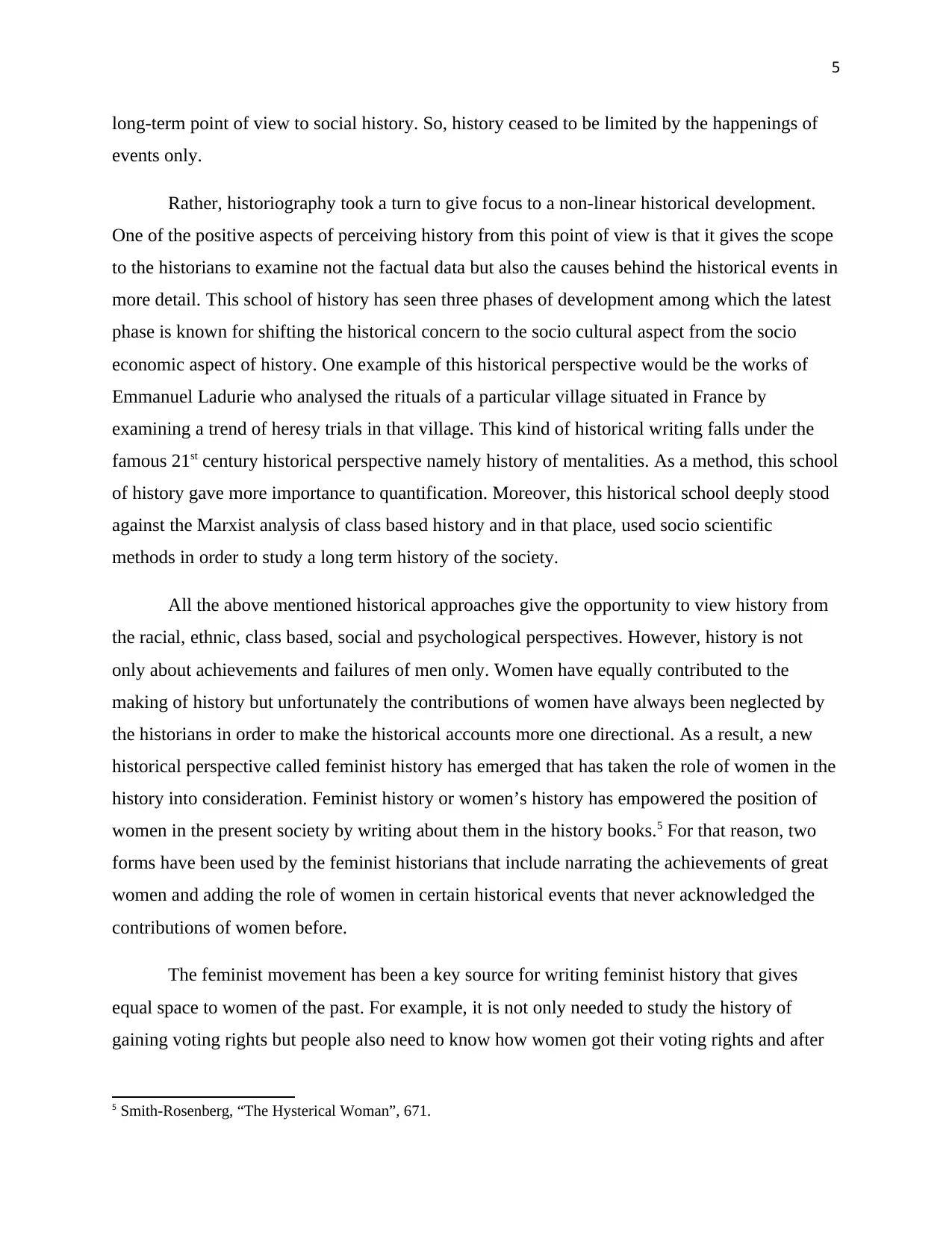
5
long-term point of view to social history. So, history ceased to be limited by the happenings of
events only.
Rather, historiography took a turn to give focus to a non-linear historical development.
One of the positive aspects of perceiving history from this point of view is that it gives the scope
to the historians to examine not the factual data but also the causes behind the historical events in
more detail. This school of history has seen three phases of development among which the latest
phase is known for shifting the historical concern to the socio cultural aspect from the socio
economic aspect of history. One example of this historical perspective would be the works of
Emmanuel Ladurie who analysed the rituals of a particular village situated in France by
examining a trend of heresy trials in that village. This kind of historical writing falls under the
famous 21st century historical perspective namely history of mentalities. As a method, this school
of history gave more importance to quantification. Moreover, this historical school deeply stood
against the Marxist analysis of class based history and in that place, used socio scientific
methods in order to study a long term history of the society.
All the above mentioned historical approaches give the opportunity to view history from
the racial, ethnic, class based, social and psychological perspectives. However, history is not
only about achievements and failures of men only. Women have equally contributed to the
making of history but unfortunately the contributions of women have always been neglected by
the historians in order to make the historical accounts more one directional. As a result, a new
historical perspective called feminist history has emerged that has taken the role of women in the
history into consideration. Feminist history or women’s history has empowered the position of
women in the present society by writing about them in the history books.5 For that reason, two
forms have been used by the feminist historians that include narrating the achievements of great
women and adding the role of women in certain historical events that never acknowledged the
contributions of women before.
The feminist movement has been a key source for writing feminist history that gives
equal space to women of the past. For example, it is not only needed to study the history of
gaining voting rights but people also need to know how women got their voting rights and after
5 Smith-Rosenberg, “The Hysterical Woman”, 671.
long-term point of view to social history. So, history ceased to be limited by the happenings of
events only.
Rather, historiography took a turn to give focus to a non-linear historical development.
One of the positive aspects of perceiving history from this point of view is that it gives the scope
to the historians to examine not the factual data but also the causes behind the historical events in
more detail. This school of history has seen three phases of development among which the latest
phase is known for shifting the historical concern to the socio cultural aspect from the socio
economic aspect of history. One example of this historical perspective would be the works of
Emmanuel Ladurie who analysed the rituals of a particular village situated in France by
examining a trend of heresy trials in that village. This kind of historical writing falls under the
famous 21st century historical perspective namely history of mentalities. As a method, this school
of history gave more importance to quantification. Moreover, this historical school deeply stood
against the Marxist analysis of class based history and in that place, used socio scientific
methods in order to study a long term history of the society.
All the above mentioned historical approaches give the opportunity to view history from
the racial, ethnic, class based, social and psychological perspectives. However, history is not
only about achievements and failures of men only. Women have equally contributed to the
making of history but unfortunately the contributions of women have always been neglected by
the historians in order to make the historical accounts more one directional. As a result, a new
historical perspective called feminist history has emerged that has taken the role of women in the
history into consideration. Feminist history or women’s history has empowered the position of
women in the present society by writing about them in the history books.5 For that reason, two
forms have been used by the feminist historians that include narrating the achievements of great
women and adding the role of women in certain historical events that never acknowledged the
contributions of women before.
The feminist movement has been a key source for writing feminist history that gives
equal space to women of the past. For example, it is not only needed to study the history of
gaining voting rights but people also need to know how women got their voting rights and after
5 Smith-Rosenberg, “The Hysterical Woman”, 671.
⊘ This is a preview!⊘
Do you want full access?
Subscribe today to unlock all pages.

Trusted by 1+ million students worldwide
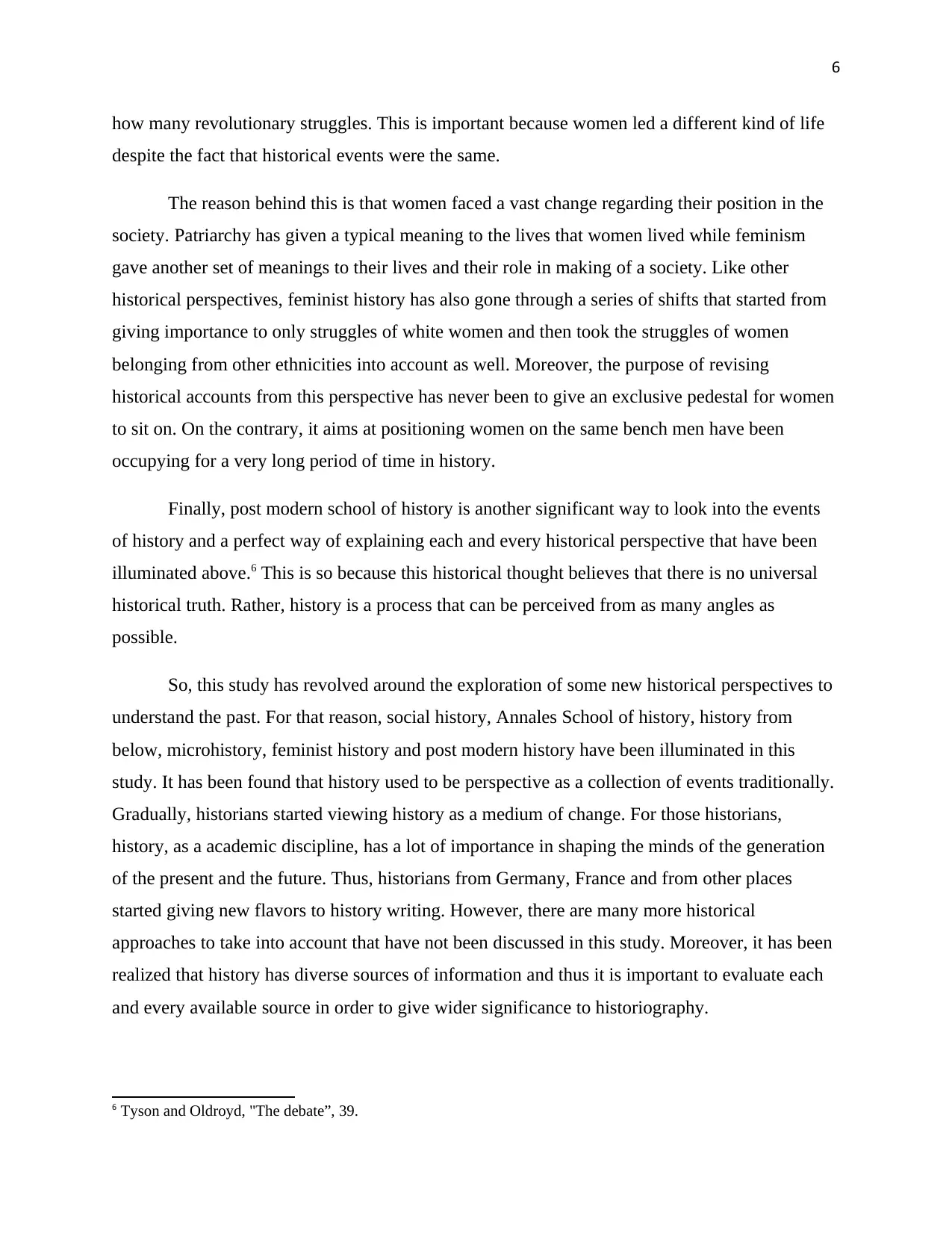
6
how many revolutionary struggles. This is important because women led a different kind of life
despite the fact that historical events were the same.
The reason behind this is that women faced a vast change regarding their position in the
society. Patriarchy has given a typical meaning to the lives that women lived while feminism
gave another set of meanings to their lives and their role in making of a society. Like other
historical perspectives, feminist history has also gone through a series of shifts that started from
giving importance to only struggles of white women and then took the struggles of women
belonging from other ethnicities into account as well. Moreover, the purpose of revising
historical accounts from this perspective has never been to give an exclusive pedestal for women
to sit on. On the contrary, it aims at positioning women on the same bench men have been
occupying for a very long period of time in history.
Finally, post modern school of history is another significant way to look into the events
of history and a perfect way of explaining each and every historical perspective that have been
illuminated above.6 This is so because this historical thought believes that there is no universal
historical truth. Rather, history is a process that can be perceived from as many angles as
possible.
So, this study has revolved around the exploration of some new historical perspectives to
understand the past. For that reason, social history, Annales School of history, history from
below, microhistory, feminist history and post modern history have been illuminated in this
study. It has been found that history used to be perspective as a collection of events traditionally.
Gradually, historians started viewing history as a medium of change. For those historians,
history, as a academic discipline, has a lot of importance in shaping the minds of the generation
of the present and the future. Thus, historians from Germany, France and from other places
started giving new flavors to history writing. However, there are many more historical
approaches to take into account that have not been discussed in this study. Moreover, it has been
realized that history has diverse sources of information and thus it is important to evaluate each
and every available source in order to give wider significance to historiography.
6 Tyson and Oldroyd, "The debate”, 39.
how many revolutionary struggles. This is important because women led a different kind of life
despite the fact that historical events were the same.
The reason behind this is that women faced a vast change regarding their position in the
society. Patriarchy has given a typical meaning to the lives that women lived while feminism
gave another set of meanings to their lives and their role in making of a society. Like other
historical perspectives, feminist history has also gone through a series of shifts that started from
giving importance to only struggles of white women and then took the struggles of women
belonging from other ethnicities into account as well. Moreover, the purpose of revising
historical accounts from this perspective has never been to give an exclusive pedestal for women
to sit on. On the contrary, it aims at positioning women on the same bench men have been
occupying for a very long period of time in history.
Finally, post modern school of history is another significant way to look into the events
of history and a perfect way of explaining each and every historical perspective that have been
illuminated above.6 This is so because this historical thought believes that there is no universal
historical truth. Rather, history is a process that can be perceived from as many angles as
possible.
So, this study has revolved around the exploration of some new historical perspectives to
understand the past. For that reason, social history, Annales School of history, history from
below, microhistory, feminist history and post modern history have been illuminated in this
study. It has been found that history used to be perspective as a collection of events traditionally.
Gradually, historians started viewing history as a medium of change. For those historians,
history, as a academic discipline, has a lot of importance in shaping the minds of the generation
of the present and the future. Thus, historians from Germany, France and from other places
started giving new flavors to history writing. However, there are many more historical
approaches to take into account that have not been discussed in this study. Moreover, it has been
realized that history has diverse sources of information and thus it is important to evaluate each
and every available source in order to give wider significance to historiography.
6 Tyson and Oldroyd, "The debate”, 39.
Paraphrase This Document
Need a fresh take? Get an instant paraphrase of this document with our AI Paraphraser
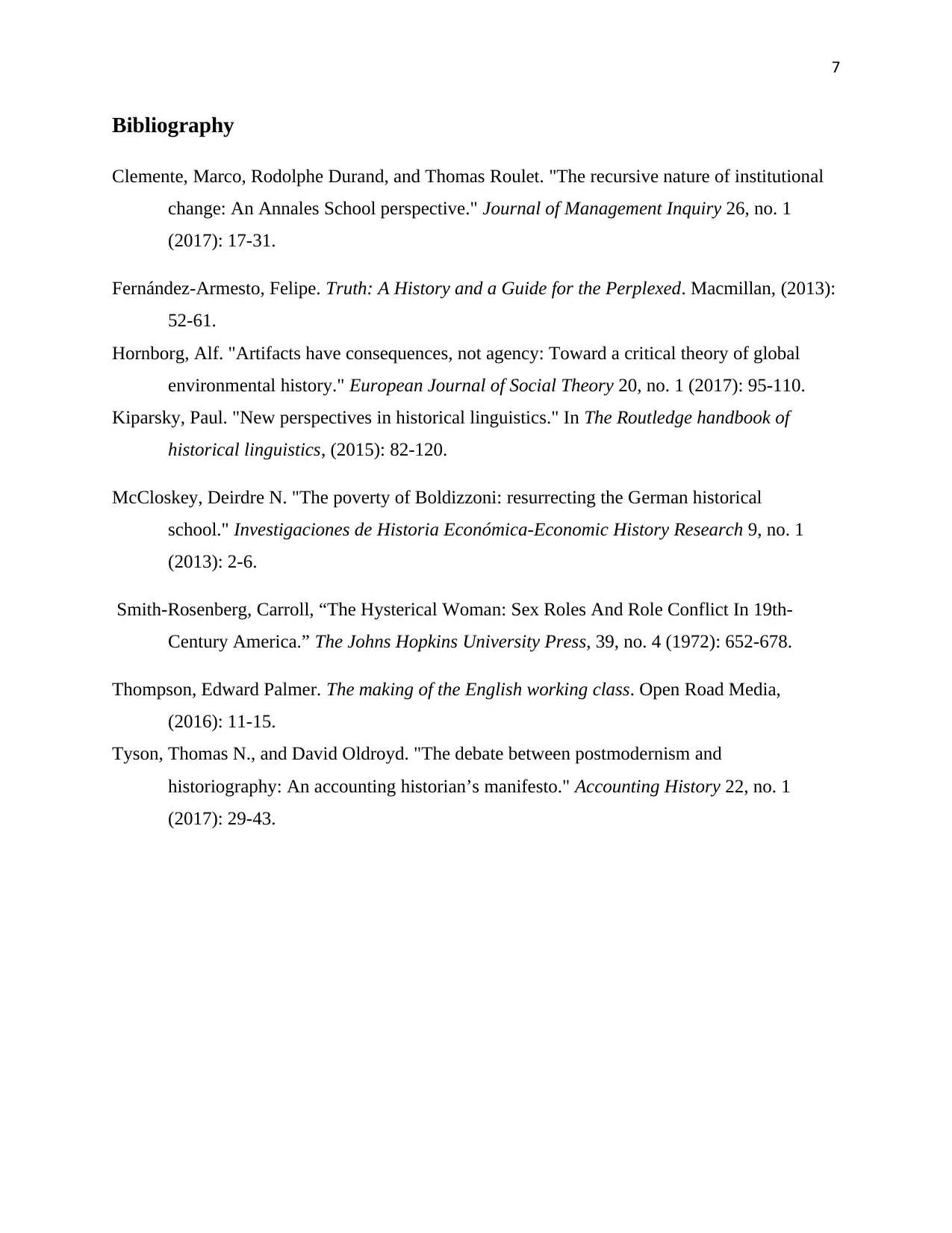
7
Bibliography
Clemente, Marco, Rodolphe Durand, and Thomas Roulet. "The recursive nature of institutional
change: An Annales School perspective." Journal of Management Inquiry 26, no. 1
(2017): 17-31.
Fernández-Armesto, Felipe. Truth: A History and a Guide for the Perplexed. Macmillan, (2013):
52-61.
Hornborg, Alf. "Artifacts have consequences, not agency: Toward a critical theory of global
environmental history." European Journal of Social Theory 20, no. 1 (2017): 95-110.
Kiparsky, Paul. "New perspectives in historical linguistics." In The Routledge handbook of
historical linguistics, (2015): 82-120.
McCloskey, Deirdre N. "The poverty of Boldizzoni: resurrecting the German historical
school." Investigaciones de Historia Económica-Economic History Research 9, no. 1
(2013): 2-6.
Smith-Rosenberg, Carroll, “The Hysterical Woman: Sex Roles And Role Conflict In 19th-
Century America.” The Johns Hopkins University Press, 39, no. 4 (1972): 652-678.
Thompson, Edward Palmer. The making of the English working class. Open Road Media,
(2016): 11-15.
Tyson, Thomas N., and David Oldroyd. "The debate between postmodernism and
historiography: An accounting historian’s manifesto." Accounting History 22, no. 1
(2017): 29-43.
Bibliography
Clemente, Marco, Rodolphe Durand, and Thomas Roulet. "The recursive nature of institutional
change: An Annales School perspective." Journal of Management Inquiry 26, no. 1
(2017): 17-31.
Fernández-Armesto, Felipe. Truth: A History and a Guide for the Perplexed. Macmillan, (2013):
52-61.
Hornborg, Alf. "Artifacts have consequences, not agency: Toward a critical theory of global
environmental history." European Journal of Social Theory 20, no. 1 (2017): 95-110.
Kiparsky, Paul. "New perspectives in historical linguistics." In The Routledge handbook of
historical linguistics, (2015): 82-120.
McCloskey, Deirdre N. "The poverty of Boldizzoni: resurrecting the German historical
school." Investigaciones de Historia Económica-Economic History Research 9, no. 1
(2013): 2-6.
Smith-Rosenberg, Carroll, “The Hysterical Woman: Sex Roles And Role Conflict In 19th-
Century America.” The Johns Hopkins University Press, 39, no. 4 (1972): 652-678.
Thompson, Edward Palmer. The making of the English working class. Open Road Media,
(2016): 11-15.
Tyson, Thomas N., and David Oldroyd. "The debate between postmodernism and
historiography: An accounting historian’s manifesto." Accounting History 22, no. 1
(2017): 29-43.
1 out of 8
Related Documents
Your All-in-One AI-Powered Toolkit for Academic Success.
+13062052269
info@desklib.com
Available 24*7 on WhatsApp / Email
![[object Object]](/_next/static/media/star-bottom.7253800d.svg)
Unlock your academic potential
Copyright © 2020–2025 A2Z Services. All Rights Reserved. Developed and managed by ZUCOL.





